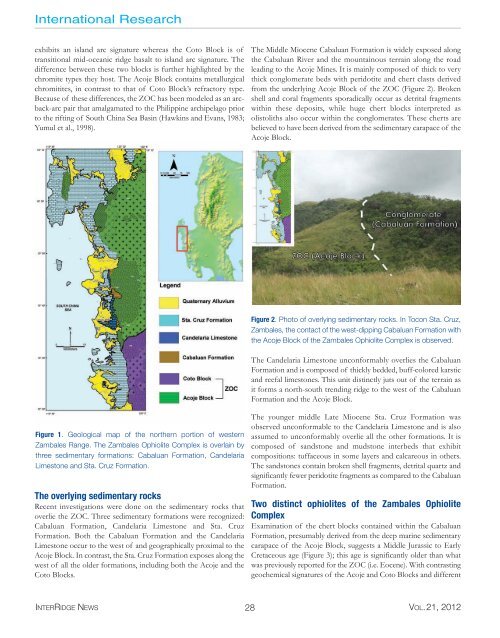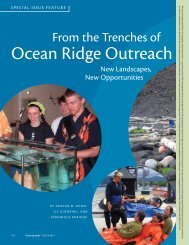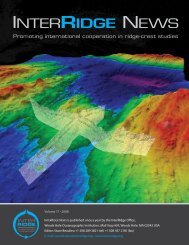Full version, low resolution, 7.5MB - InterRidge
Full version, low resolution, 7.5MB - InterRidge
Full version, low resolution, 7.5MB - InterRidge
You also want an ePaper? Increase the reach of your titles
YUMPU automatically turns print PDFs into web optimized ePapers that Google loves.
International Research<br />
exhibits an island arc signature whereas the Coto Block is of<br />
transitional mid-oceanic ridge basalt to island arc signature. The<br />
difference between these two blocks is further highlighted by the<br />
chromite types they host. The Acoje Block contains metallurgical<br />
chromitites, in contrast to that of Coto Block’s refractory type.<br />
Because of these differences, the ZOC has been modeled as an arcback-arc<br />
pair that amalgamated to the Philippine archipelago prior<br />
to the rifting of South China Sea Basin (Hawkins and Evans, 1983;<br />
Yumul et al., 1998).<br />
The Middle Miocene Cabaluan Formation is widely exposed along<br />
the Cabaluan River and the mountainous terrain along the road<br />
leading to the Acoje Mines. It is mainly composed of thick to very<br />
thick conglomerate beds with peridotite and chert clasts derived<br />
from the underlying Acoje Block of the ZOC (Figure 2). Broken<br />
shell and coral fragments sporadically occur as detrital fragments<br />
within these deposits, while huge chert blocks interpreted as<br />
olistoliths also occur within the conglomerates. These cherts are<br />
believed to have been derived from the sedimentary carapace of the<br />
Acoje Block.<br />
Figure 2. Photo of overlying sedimentary rocks. In Tocon Sta. Cruz,<br />
Zambales, the contact of the west-dipping Cabaluan Formation with<br />
the Acoje Block of the Zambales Ophiolite Complex is observed.<br />
The Candelaria Limestone unconformably overlies the Cabaluan<br />
Formation and is composed of thickly bedded, buff-colored karstic<br />
and reefal limestones. This unit distinctly juts out of the terrain as<br />
it forms a north-south trending ridge to the west of the Cabaluan<br />
Formation and the Acoje Block.<br />
Figure 1. Geological map of the northern portion of western<br />
Zambales Range. The Zambales Ophiolite Complex is overlain by<br />
three sedimentary formations: Cabaluan Formation, Candelaria<br />
Limestone and Sta. Cruz Formation.<br />
The overlying sedimentary rocks<br />
Recent investigations were done on the sedimentary rocks that<br />
overlie the ZOC. Three sedimentary formations were recognized:<br />
Cabaluan Formation, Candelaria Limestone and Sta. Cruz<br />
Formation. Both the Cabaluan Formation and the Candelaria<br />
Limestone occur to the west of and geographically proximal to the<br />
Acoje Block. In contrast, the Sta. Cruz Formation exposes along the<br />
west of all the older formations, including both the Acoje and the<br />
Coto Blocks.<br />
The younger middle Late Miocene Sta. Cruz Formation was<br />
observed unconformable to the Candelaria Limestone and is also<br />
assumed to unconformably overlie all the other formations. It is<br />
composed of sandstone and mudstone interbeds that exhibit<br />
compositions: tuffaceous in some layers and calcareous in others.<br />
The sandstones contain broken shell fragments, detrital quartz and<br />
significantly fewer peridotite fragments as compared to the Cabaluan<br />
Formation.<br />
Two distinct ophiolites of the Zambales Ophiolite<br />
Complex<br />
Examination of the chert blocks contained within the Cabaluan<br />
Formation, presumably derived from the deep marine sedimentary<br />
carapace of the Acoje Block, suggests a Middle Jurassic to Early<br />
Cretaceous age (Figure 3); this age is significantly older than what<br />
was previously reported for the ZOC (i.e. Eocene). With contrasting<br />
geochemical signatures of the Acoje and Coto Blocks and different<br />
INTERRIDGE NEWS 28 VOL.21, 2012
















